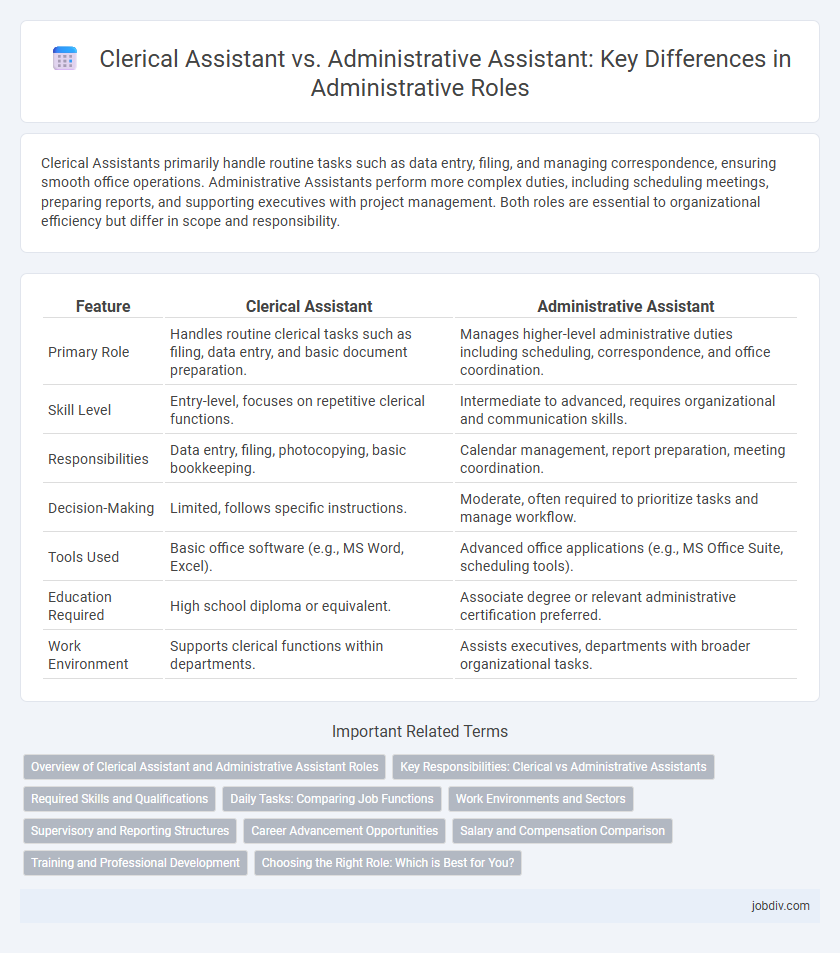Clerical Assistants primarily handle routine tasks such as data entry, filing, and managing correspondence, ensuring smooth office operations. Administrative Assistants perform more complex duties, including scheduling meetings, preparing reports, and supporting executives with project management. Both roles are essential to organizational efficiency but differ in scope and responsibility.
Table of Comparison
| Feature | Clerical Assistant | Administrative Assistant |
|---|---|---|
| Primary Role | Handles routine clerical tasks such as filing, data entry, and basic document preparation. | Manages higher-level administrative duties including scheduling, correspondence, and office coordination. |
| Skill Level | Entry-level, focuses on repetitive clerical functions. | Intermediate to advanced, requires organizational and communication skills. |
| Responsibilities | Data entry, filing, photocopying, basic bookkeeping. | Calendar management, report preparation, meeting coordination. |
| Decision-Making | Limited, follows specific instructions. | Moderate, often required to prioritize tasks and manage workflow. |
| Tools Used | Basic office software (e.g., MS Word, Excel). | Advanced office applications (e.g., MS Office Suite, scheduling tools). |
| Education Required | High school diploma or equivalent. | Associate degree or relevant administrative certification preferred. |
| Work Environment | Supports clerical functions within departments. | Assists executives, departments with broader organizational tasks. |
Overview of Clerical Assistant and Administrative Assistant Roles
Clerical assistants primarily handle routine office tasks such as data entry, filing, and managing correspondence to ensure smooth daily operations. Administrative assistants take on more complex responsibilities including scheduling, project coordination, and supporting executive functions to enhance organizational efficiency. Both roles are crucial in maintaining effective office administration but differ in scope and level of responsibility.
Key Responsibilities: Clerical vs Administrative Assistants
Clerical assistants primarily handle routine tasks such as data entry, filing, and managing correspondence, ensuring smooth day-to-day office operations. Administrative assistants take on broader responsibilities including scheduling, coordinating meetings, preparing reports, and supporting senior staff with project management. The distinction lies in clerical roles focusing on operational support, while administrative roles involve strategic organizational duties.
Required Skills and Qualifications
Clerical Assistants require proficiency in basic office software, data entry, and organizational skills to manage filing systems and routine correspondence efficiently. Administrative Assistants demand advanced communication abilities, project management experience, and specialized knowledge in scheduling, budgeting, and supporting executive-level tasks. Both roles benefit from strong attention to detail, multitasking capabilities, and a high level of professionalism in handling confidential information.
Daily Tasks: Comparing Job Functions
Clerical assistants primarily handle routine tasks such as data entry, filing, and managing correspondence, emphasizing organizational support within the office environment. Administrative assistants perform broader responsibilities including scheduling meetings, preparing reports, and assisting in project coordination, which demands higher levels of communication and multitasking skills. Both roles contribute to office efficiency, but administrative assistants typically engage in more complex activities that support management and operational workflows.
Work Environments and Sectors
Clerical Assistants commonly work in environments such as schools, hospitals, and retail offices, handling routine administrative tasks like filing, data entry, and answering phones. Administrative Assistants are typically found in corporate settings, law firms, and government agencies, where they manage more complex responsibilities including scheduling, correspondence, and project coordination. Both roles span sectors like education, healthcare, finance, and public administration, but Administrative Assistants often engage with higher-level organizational functions.
Supervisory and Reporting Structures
Clerical Assistants typically report to Administrative Assistants or office managers, handling routine tasks under close supervision. Administrative Assistants often have broader responsibilities, including supervising Clerical Assistants and coordinating workflow within departments. The supervisory structure places Administrative Assistants in mid-level roles, managing reporting lines and facilitating communication between staff and upper management.
Career Advancement Opportunities
Clerical assistants often perform routine tasks such as data entry and filing, which provide foundational skills but limited career advancement prospects. Administrative assistants handle more complex responsibilities including project coordination and communication management, opening pathways to supervisory roles and specialized administrative positions. Developing proficiency in office software, organizational skills, and interpersonal communication significantly enhances career progression opportunities in administrative support fields.
Salary and Compensation Comparison
Clerical Assistants typically earn an average annual salary ranging from $30,000 to $40,000, reflecting entry-level administrative support roles focused on routine tasks. Administrative Assistants command higher compensation, with salaries often between $40,000 and $55,000 annually, due to increased responsibilities such as managing schedules and handling complex communications. Benefits packages for Administrative Assistants commonly include bonuses, health insurance, and retirement plans, contributing to overall higher total compensation compared to Clerical Assistants.
Training and Professional Development
Clerical Assistants typically receive on-the-job training focused on basic office tasks such as filing, data entry, and answering phones, while Administrative Assistants undergo more comprehensive training that includes project management, scheduling, and communication skills. Professional development opportunities for Administrative Assistants often involve leadership training, software proficiency upgrades, and specialized certifications like Certified Administrative Professional (CAP). Investing in advanced training enhances Administrative Assistants' ability to handle complex responsibilities, whereas Clerical Assistants usually progress through experience and skill refinement.
Choosing the Right Role: Which is Best for You?
Clerical Assistants typically handle routine administrative tasks such as data entry, filing, and answering phones, making them ideal for individuals seeking structured, detail-oriented roles. Administrative Assistants often take on broader responsibilities including calendar management, correspondence, and project coordination, suited for those aiming to support higher-level management and develop organizational skills. Assessing your career goals, preferred workload, and desired interaction level can help determine whether a Clerical or Administrative Assistant role aligns best with your professional aspirations.
Clerical Assistant vs Administrative Assistant Infographic

 jobdiv.com
jobdiv.com